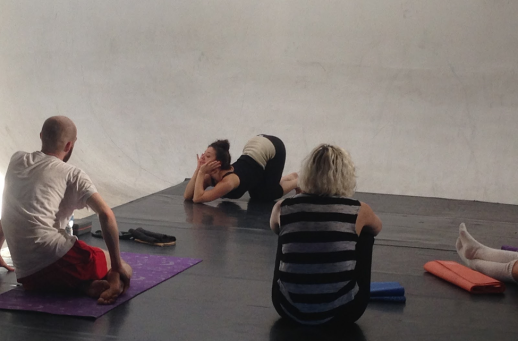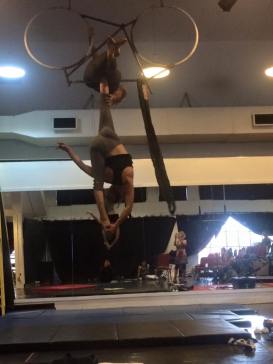CCAFT V4: ANCHORED IN THE PAST, I COMMIT FULLY TO THE PRESENT, MAINTAINING A VISION OF THE FUTURE WE WILL IMAGINE
By Sarah Muehlbauer
CCAFT 2016 Festival Dramaturge
The Contemporary Circus Arts Festival of Toronto coalesced in year four of its existence, like any social organism, responsive to its environment. 2016 was a year to mine artistic practice guided by an invitation to move deeper into skill and mastery through multi-day intensives. While outwardly it appeared as a contraction—rather, this structure reflected a self-conscious choice by festival producers Leary and Leonard to offer a limited number of classes with greater sensitivity; this was a call to the community to dig deeper roots.
Founded by Anandam Dancetheatre’s Brandy Leary and A Girl in the Sky Production’s Rebecca Leonard, CCAFT was designed to cultivate the Toronto circus arts sense of community while addressing accessibility issues in the educational environment. Leonard and Leary came together as pioneering and established artists who had, at their own risk and expense, traveled widely in pursuit of skills and experiences to accomplish a high-achieving performing arts path. Understanding that this investment was not universally possible (or at least, not perceived to be so…) they gathered world class professionals from their networks to bring training home to their local environment. The first three festivals featured 2-3 hour workshops in a variety of disciplines, introducing a wide set of tools students might use as future creators. Initial years emphasized a sense of grounding in the mechanics of healthy movement as well as rigging, prioritizing responsibility and ensuring the protective environment necessary for growth.

“Emerging Artists” Valerie Arthur and Sara Greenberg, curated by Emily Hughes photo Ken Dobbs
In the years since CCAFT’s launch, the Toronto circus community has grown continually and recognized the value in curating outside influences. The collective scene has stepped up to invite continued short-form workshops, which has allowed CCAFT to shift its role and to ask new questions. This year we saw the development of the festival’s new “Catalyst” program, launching late 2016 and spanning across 2017, is designed to support emerging Toronto artists by providing resources; this includes a micro-grant, access to studio space, mentorship, and an opportunity for the artists to present their work in CCAFT’s artist showcase for the coming 2017 festival. This new and ongoing program provides a crucial support package, a link in the chain between “emerging” and “established” artists, and a platform to raise the expectations and output of the community at a pivotal time in personal and collective development.
Another goal of this year’s festival was to continue emphasis on artistry beyond skill. 2015’s gathering introduced the process of the “Creation Relay”, a co-led 5-day immersion which hacked artistic technique and unsettled an already uneasy definition of circus. With this year’s workshop offerings, we saw the immersive structure opened up to the entire community. Andérane Leclerc presented “Contortion for All”, a deep and subtle investigation of interiority and bodily limits. With direct and sophisticated cues to build awareness of healthy joint mobility and space within the body, Leclerc presented a grounded yet phenomenological approach to building a contortion practice. With a fundamental focus on the cleansing of the spine, a deepening of the core in all dimensions through the use of spirals, figure-8’s, and half-circles reminiscent of the foundations of gyrotonic, Leclerc’s process emerges from an intuitive standpoint that reflects a depth of conceptual research in her own practice. This combination provides a unique perspective and example for artists with interest in extending flexibility into the concept of their work.

Andérane Leclerc’s “Contortion for All”
Sonia Norris’s “Circus Devising and Dramaturgy: Creating New Work” challenged artists to continue independent creation concepts under the guidance of an accomplished Toronto director and dramaturge. Through writing, acting, and invention, artists were provoked to develop rigorous attention to detail and storytelling which in many ways is foreign to the teaching style traditionally available to local community. Artists were questioned to justify lyrical movement, to dissect plot and gesture, to clarify thought leading to action, and to dance between concrete narrative storytelling and the inherent dramaturgy of skill. As circus artists, many of our tools are plastic forms which must be seamed together, and in many ways skill’s inherent shape dictates a finite capacity of interpretation. But with a heightened consciousness of our audience’s experience, we are able to actively construct meaning based on the limitations and opportunities we co-create.
Aimée Hancock’s “Mixed Aerial Apparatus: Research and Creation” held similar motivations, with perhaps a greater emphasis on skill as primary form. Beginning with a fundamental teaching philosophy of tenderness, Hancock facilitated play and stage-sharing on apparatuses that so-often develop in solo. From this safe space, she troubled a level of skill already developed, challenging students to ask better questions of their motivation and practice. Breaking down form into phrases, positioned with language, visuals, and music as translation tools to provide clarity and structure, she gently guided choices to engage both internal and external awareness. Smaller classes translated to a more individualized learning experience, and in the end festival reflections revealed a desire for more time, as if an invitation to practice more deeply only increases an artist’s thirst.
As was true in the Creation Relay of last year’s fest, a move toward immersion is a step away from the immediacy of skill and product. CCAFT has taken an active role in supporting the cultivation of unique voices and the development of practice, which serves a different responsibility than what artists are often called to put forth in the economic spectrum. This choice is not to suggest a hierarchy, but to present a broad continuum of style and function instilled with a sense of awareness, purpose, and dedication to an audience in whatever context we present. It is less to define “what is circus?” but “what are we doing with it?” Here we find the space that allows for work to be “embodied, political, and full of failure”, fundamentals of socially conscious art.
True to this mission and the dedication it takes, we can celebrate that this was the first year that CCAFT received government funds, moving towards its intended goal of achieving ongoing economic stability for artist’s presentation and development. This year also extended an invite for local curators to select presenting artists for the festival showcase, continuing a commitment to shared leadership and the diversity of voices at all levels.
CCAFT begins and ends with a closing circle open to anyone willing to join and share their experience and visions for the future. We come together with collective breath and at each exhale there is an emptying. A sense of balance is achieved through a reflection on what was, a ceremony for what is, and a commitment for what is-not-yet, but should be.

CCAFT 2016 Sonia Norris’s Devising and Dramaturgy
